There might be affiliate links on this page, which means we get a small commission of anything you buy. As an Amazon Associate we earn from qualifying purchases. Please do your own research before making any online purchase.
Gratitude has for most of its history remained a discussion topics of pastors. As a growing field of science is starting to show, the benefits of cultivating an attitude of gratitude are very real and can be enjoyed outside a religious context.
This page summarizes at a high level the prominent research in the field, and provides a link to full studies where available.
Sidebar: Want to get started right away with practicing gratitude? If so, then check out our physical journal called The 90-Day Gratitude Journal: A Mindful Practice for a Lifetime of Happiness. With this journal, you will build a powerful daily gratitude habit and re-discover all the great things that are already in your life.
Emotion and Social Context: An American—German Comparison
20% of American adults rated gratitude as a constructive and useful emotion, compared to 50% of Germans. 10% of Americans responded that they “regularly and often” experience the emotion of gratitude, as compared to 30% of Germans.
Research Information
- Date & Journal: 1988, British Journal of Social Psychology
- Authors: Shula Sommers and Corinne Kosmitzki
- Sample size: 105 American and 40 German adults
- Abstract here.
Is Gratitude a Moral Affect?
Authors establish gratitude as a moral affect . “We are…proposing … that gratitude typically results from and stimulates moral behavior, that is, behavior that is motivated out of concern for another person… We liken gratitude to other moral affects such as empathy, sympathy, guilt, and shame.”
This proposal is supported with the four following hypotheses:
1. Gratitude is used as a moral barometer, in that it is used to emotionally feel the size and nature of a gift from another. The supporting studies cited showed that people are more likely to feel gratitude towards: acts done by strangers than family members, larger acts than smaller acts, more inconvenient acts, acts that confer benefits which themselves are not necessary because of a situation caused by the benefactor, people with higher status, and people who were generally nicer. People were also significantly more likely to feel gratitude when their declaration of gratitude would be public.
2. Gratitude is used as a moral motive – that is, it encourages pro-social behavior, and discourages societaly disruptive behavior. Three studies cited showed that those who felt gratitude were more likely to help others.
3. Expressions of gratitude reinforce moral behavior. This is supported through multiple studies, all which show that expressions of gratitude encourage pro-social behavior in the future. For example, thanking case managers induced greater visitation, greater volunteerism, helping a stranger pick up dropped books, and spending more at a store. The noted exception is that humans have a built in defense mechanism against overt attempts to use expressions of gratitude for greedy reasons (e.g. to get customers to spend more money). In addition, one referenced study showed that an expression of gratitude colors the recipients emotional valance of the benefactor and events sounding their interaction towards a more positive light.
4. Gratitude can be correlated with certain personality traits. This is proven only half true – only agreeableness is shown to be positively correlated with gratitude (and narcissism negatively correlated). Unexpectedly, extroversion, conscientiousness and neuroticism had nearly no correlation with gratitude.
Research Information
- Date & Journal: 2001, Psychological Bulletin
- Authors:Michael E. McCullough, Shelley D. Kilpatrick, Robert A. Emmons, David B. Larson
- Full study here.
Free Download: The 90-Day Gratitude Journal
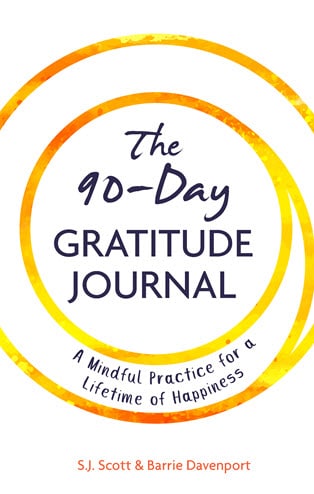
Want to get started right away with practicing gratitude?
If so, then download the free digital version of my best-selling journal called “The 90-Day Gratitude Journal: A Mindful Practice for a Lifetime of Happiness.”
With this journal, you will build a powerful daily gratitude habit and re-discover all the great things that are already in your life.
Click or tap this link to grab your copy: https://www.happierhuman.com/gratitude-journal
The Grateful Disposition: A Conceptual and Empirical Topography
Authors explored what emotional states and personality factors give rise to gratitude through four studies.
They first define four dimensions of gratitude: intensity, frequency, span, and density.
- Intensity: The depth of the feeling, from a slight emotional tug to overflowing tears.
- Frequency: The ease with which grateful feelings are elicited.
- Span: The number of different things for which a person can be grateful for at the same time.
- Density: The number of different people for which a person can be grateful for a single positive outcome.
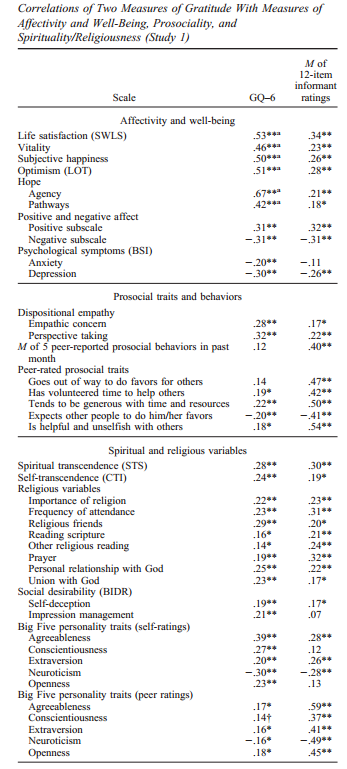
In the first study, a wide range of personality factors were tested against the GQ-6, a measure of gratitude.In addition to information collected from each participant, information was collected from four informants who knew each subject well.
Measures of well-being had the strongest correlation with gratitude, oftentimes greater than .5 (as seen in the table to the right). Pro-social traits and measures of spirituality were also correlated with gratitude (~.15 to .30).
The personality trait of agreeableness had the strongest positive correlation with gratitude, of .39, while neuroticism had the strongest (and only) negative correlation, of -.30.
The second study measured similar factors and traits, but was different in two regards. First, it was much larger, with six times the sample size (n=1,228). Second, rather than the usual college student, participants were adults, 80% female, and contacted through the web.
The results were similar to those of study 1, with the notable difference that most of the correlations were stronger (e.g. .32 for extroversion vs. .2 and .53 for spiritual transcendence vs. .24).
The third study was similar to the first one, except that materialism and envy were also measured (Belk Materialism Scale and Dispositional Envy Scale).
Materialism and envy had strong negative correlations with measures of gratitude. The materialism sub-scales had negative correlations ranging from -.07 to -.38, and the envy scale of -.39.
“Grateful people report themselves as being less materialist and less envious. In particular, grateful people report being more willing to part with their possessions, more generous with them, less envious of the material wealth of others, less committed to the idea that material wealth brings happiness. Apparently, material success is not a very important factor in the happiness of highly grateful people.”
The fourth study combined the data from the first three studies, and attempted to isolate individual correlations. For example, extroversion and agreeableness are both correlated with gratitude, but they are also both correlated with each other.
After controlling for agreeableness, the magnitude of nearly all correlations fell. Overall, the Big Five personality traits combined could account for 30%-50% of the overall variation in a person's level of gratitude.
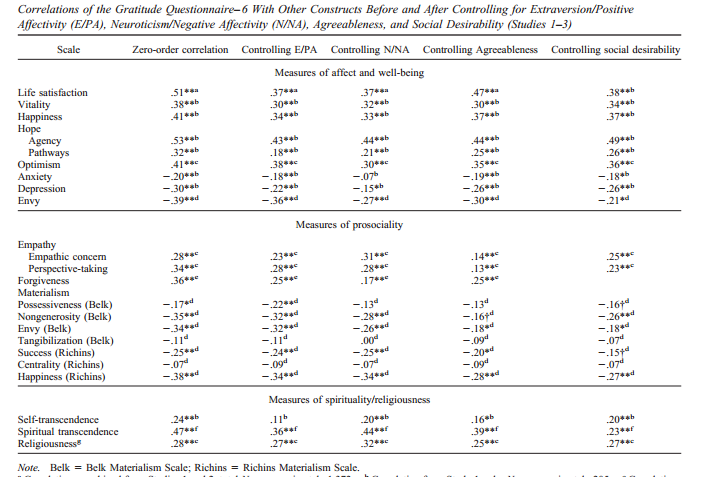
Research Information
- Date & Journal: 2002, Journal of Personality and Social Psychology
- Authors: Michael E. McCullough, Robert A. Emmons, Jo-Ann Tsang
- Sample size: Study 1 – 238; Study 2 – 1,228; Study 3 – 156
- Fully study here.
Counting Blessings Versus Burdens: An Experimental Investigation of Gratitude and Subjective Well-Being in Daily Life
Authors conducted three studies.
In the first study, subjects were asked to complete a weekly gratitude journal, weekly burdens journal, or a weekly neutral journal for nine weeks.
Gratitude Condition:
There are many things in our lives, both large and small, that we might be grateful about. Think back over the past week and write down on the lines below up to five things in your life that you are grateful or thankful for.
Burdens Condition:
Hassles are irritants—things that annoy or bother you. They occur in various domains of life, including relationships, work, school, housing, finances, health, and so forth. Think back over today and, on the lines below, list up to five hassles that occurred in your life.
Despite the extreme infrequency of the journaling, there were still significant results.
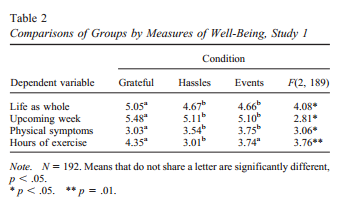
The grateful group reported increased well-being, had better health, exercised more (~40 min./week), felt life was better (~8% better), and had increased optimism (~5% more).
In the second study, subjects were asked to complete a daily gratitude journal, daily burdens journal, or a downward social comparisons journal for two weeks.
Gratitude & Burdens Condition same as in study 1 (except daily instead of weekly).
Downward Social Comparison Condition:
It is human nature to compare ourselves to others. We may be better off than others in some ways, and less fortunate than other people in other ways. Think about ways in which you are better off than others, things that you have that they don’t, and write these down in the spaces below.
As expected, there was a stronger response due to the increased frequency of the journaling.
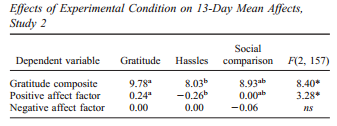
Perhaps because of the reduced duration (2 weeks vs 9), or perhaps because the first result was a fluke, there was no significant impact of the gratitude intervention on measured health variables (e.g. hours of exercise, sleep quality, asprin, caffeine, and alcohol usage). However, those in the gratitude group did report increased pro-social behavior (offering emotional support and help with a problem).
In the third study, all subjects chosen had a neuromuscular disease (as compared to the usual healthy college student). In addition, there were only two groups – a gratitude group with the same instructions as before, and a control group. The study was extended to three weeks, and and reports were collected from the subject's closest relationship, to see if changes were observable to more than the subjects internal narrative.

The impact on well-being, optimism and social connectedness was similar to in studies 1 and 2. Similar to in study 2, there was no impact on measured health variables. However, there was one exception – subjects in the gratitude condition reported getting half an hour more sleep (7.58 hrs.) as compared to the control (7.06). These changes were noticed on the reports by the subject's closest relationship.
Research Information
- Date & Journal: 2003, Journal of Personality and Social Psychology
- Authors: Michael E. McCullough, Robert A. Emmons
- Sample size: Study 1 – 192; Study 2 – 157; Study 3 – 65
- Full study here.
- Gratitude and Happiness: Development of a Measure of Gratitude, and Relationships With Subjective Well-Being (2003, P C Watkins, K Woodward, T Stone, R L Kolts) [PDF]
Gratitude in Intermediate Affective Terrain: Links of Grateful Moods to Individual Differences and Daily Emotional Experience
Authors conducted two studies, first providing a conceptual overview of the three definitions of gratitude:
- Gratitude as an (affective) trait: A built in, personality level trait which determines how often and deeply we feel gratitude.
- Gratitude as a mood: Gratitude as a singular emotion lasts for only a few seconds. To explain how gratitude inducing interventions like a gratitude journal work, rather than changing our personality trait, they instead induce a mood of gratitude, which in turn gives rise to more gratitude emotions.
- Gratitude as an emotion: The actual positive emotions which recognize the intentional, beneficial actions of others – lasts only a few seconds.
These two studies explored the relationship between the three levels of gratitude: trait, mood, and emotion.
In the first study, adults with a neuromuscular disease were used as subjects. Subjects were given a battery of surveys, and at the end of each night were asked to describe, on a 1 to 5 scale, the extent to which they felt a variety of emotions that day. That is, this was a three week observational study. This study wished to explore which life traits and circumstances could be used to predict the subject's mean level of gratitude over the course of the study. The table on the right provides the results:
- The initial self-report measure of gratitude (GQ-12) was extremely predictive of how much gratitude the subject would feel over the next three weeks, with a correlation of .72.
- Depression was also extremely predictive, with a correlation of -.68.
- Measures of spirituality were highly predictive, with a correlation of .60.
- Given that these subjects were not in a social stimulating environment, extraversion had a high correlation of .54.
- Positive and negative affectivity had an asymmetric relationship, with positive affect three times as predictive as negative affect.
- Optimism had a strong correlation of .40. This is part causality and part correlation. In one gratitude intervention, participants showed an increase in optimism. However, the increase was not as large as .40.
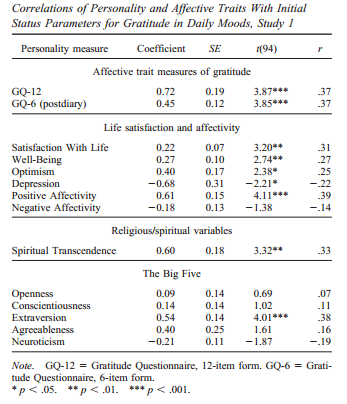
Study 2 was similar, except that healthy college students were used as subjects, it was for 2 weeks rather than 3, and more questions were given.
This study uncovered four characteristics of gratitude that study one did not.
- Of the many religious variables collected (quest orientation, intrinsic/extrinsic religious orientation, religious interest, etc…) only self-transcendence had a strong correlation with mean levels of experienced gratitude (r=.49). Looking at the questions that make up the self-transcendence sub-scale, this makes sense.
- Empathic concern had the highest correlation yet, of any study on gratitude so far (r=.84). It is unclear what makes the correlation so large and which way causality is working (if it all).
- Agreeableness had a correlation of .53, similar to but larger than the results of study one, but extroversion had a correlation of only .16, one-fourth of prior results. This is likely because the subjects are different – the authors suggest that because college subjects are already in a rich social environment, agreeableness rather than extroversion is the more relevant trait.
This study also analyzed the correlation between the different dimensions of gratitude (density, frequency, intensity, and span) with experienced mood gratitude.
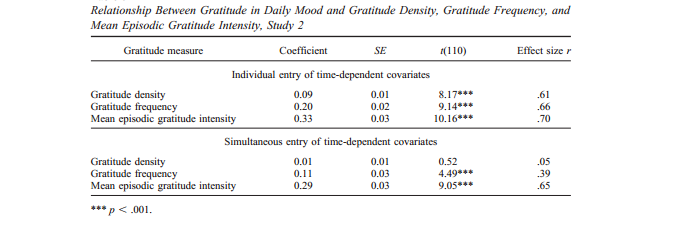
The results suggest that a grateful disposition interacts with daily emotional experience through what the authors call the resistance hypothesis.
For those with a high level of trait gratitude, the frequency of gratitude inducing events, as well as their density (the number of different people for which a person can be grateful for a single positive outcome) were not significantly correlated with experienced gratitude (r=.21 & r=.22); only the mean intensity (the depth of the feelings) was significantly predictive (r=.61).
On the other side, for those with a low level of trait gratitude, frequency, density, as well as intensity were all significantly correlated with experienced gratitude (r=.72, r=.58, and r=.59).
This suggests that those that are dispositionally grateful self-generate their grateful moods and emotion, and need an extra intense dose of induced gratitude to increase the valence of their grateful mood. Said differently, “the amount of gratitude in their daily moods is determined so thoroughly by personality processes that their moods are resistant to the effects of gratitude-relevant daily life events and their discrete emotional responses to these daily events.
In contrast, because those with a low trait gratitude already experience so little gratitude, their mood gratitude is highly reactive to gratitude-relevant daily life events.
This information suggests that those with different levels of trait gratitude would be best able to increase their levels of gratitude through different means.
(a) the benefit’s costliness to the benefactor (b) its value to the beneficiary (c) the intentionality with which it was rendered, and (d) the extent to which it was given even without relational obligations to help (for example, parents’ obligations to help their children).
“Obligation feels negative and uncomfortable, whereas gratitude is usually associated with contentment and well-being.”
Research Information
- Date & Journal: 2004, Journal of Personality and Social Psychology
- Authors: Michael E. McCullough, Robert A. Emmons, Jo-Ann Tsang
- Sample size: Study 1 – 96; Study 2 – 112
- Full study here.
Positive Psychology Progress
A one time act of thoughtful gratitude produced an immediate 10% increase in happiness and 35% reduction in depressive symptoms, but the effects disappeared within six months and three months, respectively.
On the other hand, instructing participants to write down three things that went well and their causes every night for one week had a long-lasting impact.
After one week, participants were 2% happier than before, but in follow-up tests, their happiness kept on increasing, from 5% at one month, to 9% at six months. All this, even though they were only instructed to journal for one week. Participants enjoyed the exercise so much, that they just kept on doing it on their own.
Research Information
- Date & Journal: 2005, American Psychologist
- Authors: Martin Seligman, Tracy A. Steen, Nansook Park, Christopher Peterson
- Sample size: 150
- Abstract here.
Is Gratitude an Alternative to Materialism?
(Again, if you'd like to build a gratitude practice, then this journal can help.)
Authors explore the connection between gratitude and materialism.
Materialism: “A persistent emphasis on lower-order needs for material comfort and physical safety over higher-order needs such as self expression and quality of life.”
Materialism has been shown to harm psychological well-being, and so is a losing strategy for the individual. However, materialism in others may be beneficial, as it encourages entrepreneurship and GDP growth, and encourages wealth and status signaling (e.g. in person you may not be able to tell that Warren Buffet is exceptionally rich, given his reputation for not being materialistic, but in front of most other rich people – they will make the effort to make sure you know that they are rich).
The authors then explore two development routes which give rise to the personality trait of materialism:
- Insecurity. Those who have not had “their basic psychological needs met – needs such as safety, competence, connectedness, and autonomy” are more likely to be materialistic. Three examples in particular are those who have high self-doubt, those who come from poor families, and those whose who had parents which failed to provide requisite levels of emotional support.
- Role models. Quite sadly, Americans are inundated with materialistic role models, every single day. From advertisements which highlight materialistic themes to celebrity culture which glorifies the rich and frivolous, to business culture in which we are told our dreams should be to be rich and powerful.
The evidence is clear – while economic motivation is a prerequisite for a stable life (e.g. the unemployed have higher rates of depression), high economic motivation (e.g. materialism) is strongly correlated with reduced well-being and increased rates of mental disorder.
The authors then make the case that gratitude and materialism are inversely related.
In one study, (McCullough 2002) those who had a high level of gratitude as a personality trait were much more likely to have below-average levels of materialism. Polak 2005 showed the same results.
Lerner and Ketlner (2000, 2001) show that gratitude focuses our attention on others (e.g. instead of believing we control our fate, we start looking at others as agents of change in our lives). Furthermore, gratitude shifts the color of that focus to the positive – not only are others effecting us, but they are doing so in a positive way. This in turn gives the impression that one is surrounded by benevolent agents, which itself destroys insecurity, which is one of the primary drivers behind materialism.
The last argument the authors bring up is that those who are more grateful are more social, and so not only perceive the environment to be more benevolent, but actually make it so by helping others more frequently and accumulating social capital.
Research Information
- Date & Journal: 2006, Journal of Happiness Studies
- Authors: Emily L. Polak, Michael E. McCullough
- Full study here.
Positive Responses to Benefit and Harm: Bringing Forgiveness and Gratitude into Cognitive Psychotherapy
Authors summarize current state of gratitude research as it can be applied to psychotherapy.
They first argue that focusing on victimization, blame, and negative emotions harms both physical and mental well-being. The cite about a dozen studies which support that argument. They then make the more controversial claim that forgiveness improves physical and mental well-being. Several studies are mentioned which offer the hope of promising results: both imagined and real forgiveness improved cardiovascular and sympathetic nervous system functioning in four studies. In one, forgiveness also lowered amounts of cortisol.
Several mechanisms are suggested through which forgiveness produces positive results (e.g. preservation of close relationships, increased optimistic thinking, a blocking out and replacement of negative emotions, etc…).
They then suggest several mechanisms which explain and could be used to induce forgiveness, citing a meta-analysis which found that forgiveness interventions, on average, increases participant's forgiveness scores by 43%. These mechanisms are: empathy for the transgressor, recognition of one's own flaws and shortcomings, generous attributions and appraisals for the transgressor's behavior, and rumination about the transgression.
Finally, the authors explore why and how best to help patients experience gratitude. The how has been extensively covered elsewhere on this page.
First, of all the possible ways of recalling grateful events (e.g. gratitude journal, writing an essay, thinking, etc…), thinking had the strongest impact; however, all ways produced positive results. The authors suggest thinking was the most powerful because, “writing an essay or a letter of gratitude on demand may have disrupted the experience of positive affect.”
Second, the authors provide a number of additional ways that gratitude can be cultivated. Because of its high information value, this text is copied in its entirety rather than summarized:
“Research has also shown that gratitude or thankfulness can be increased as a function of interventions designed for other purposes. For example, meditation can promote gratitude as a quality of mindfulness (Shapiro, Schwartz, & Santerre, 2002), progressive muscle relaxation can help produce increased feelings of love and thankfulness (Khasky & Smith, 1999), and merely imagining being forgiven by one’s victim can increase feelings of gratitude, presumably by making one grateful for being given the gift of forgiveness (Witvliet, Ludwig, & Bauer, 2002).
These studies demonstrate that interventions aimed at increasing one’s focus on the relationship between mind and body can also help engender grateful mindsets in people. In fact, a particular type of psychotherapy originating in Japan, known as Naikan therapy, orchestrates all of the above techniques so as to expand clients’ awareness of their moral relationships with others (in terms of giving, receiving, and hurting) and aims to induce in clients a strong sense of gratitude to people who have provided them with benefits (Hedstrom, 1994; Reynolds, 1983).”
Research Information
- Date & Journal: 2006, Journal of Cognitive Psychotherapy
- Authors: Giacomo Bono, Michael E. McCullough
- Full study here.
Other Related Studies and Articles:
- Gratitude: The parent of all virtues (2007, Wood, A. M., Joseph, S., & Linley, P. A): Is an easy to read, informative review of the state of the field; no new hypotheses or research. Full study here.
- Coping Style as a Psychological Resource of Grateful People (2007, Wood, A. M., Joseph, S., & Linley, P. A) Full study here.
- Gratitude uniquely predicts satisfaction with life: Incremental validity above the domains and facets of the five factor model (2008, Wood, A. M., Joseph, S., & Maltby, J.) Full study here.
- Conceptualizing Gratitude and Appreciation as a Unitary Personality Trait (2008, Wood, A. M., Maltby, J., Stewart, N., & Joseph, S.) Full study here.
- A Social–Cognitive Model of Trait and State Levels of Gratitude (2008, Wood, A. M., Maltby, J., Stewart, N., Linley, P. A., & Joseph, S.) Full study here.
Free Download: The 90-Day Gratitude Journal

Want to get started right away with practicing gratitude?
If so, then download the free digital version of my best-selling journal called “The 90-Day Gratitude Journal: A Mindful Practice for a Lifetime of Happiness.”
With this journal, you will build a powerful daily gratitude habit and re-discover all the great things that are already in your life.
Click or tap this link to grab your copy: https://www.happierhuman.com/gratitude-journal
An Adaptation for Altruism? The Social Causes, Social Effects, and Social Evolution of Gratitude
Authors explore the social causes, social effects, and social evolution of gratitude.
They first explore three different pro-social functions gratitude can provide:
- As a benefit detector: “Gratitude is responsive to four types of information about the benefit-giving situation:
- As a reinforcer of pro-social behavior: “Expressions of gratitude (for example, saying ‘‘thanks’’) increase the likelihood that benefactors will behave prosocially again in the future.” This has been borne in a several studies, and cab be easily confirmed in personal experience – we are much less likely to help those that do not appreciate our efforts.
- As a motivator of pro-social behavior: Feelings of gratitude encourage reciprocation on the part of the recipient. This too is suggested by the results of several studies: those who have higher trait gratitude are more likely to be helpful, and those that implement a gratitude journal are more likely to help others.
They then discuss the differences between gratitude and indebtedness/obligation.
The authors also cite several studies which show that gratitude predicts request compliance, whereas indebtedness may not. The difference is that gratitude is felt in return for kindness freely given, while indebtedness is felt when help is given with the explicit understanding of being re-paid later.
The authors finish by discussing two hypotheses which explain how gratitude evolved.
- As a mechanism of reciprocal altruism. The most interesting piece of supporting evidence is that we feel significantly more gratitude in response to the acts of strangers than family members. As altruism by its nature is meant to help strangers, not those with whom we share DNA, gratitude excludes family members. This is disheartening, because it suggests that experiencing gratitude for family members on a regular basis requires fighting our biology.
- As a mechanism of upstream reciprocity. Said simply, the reason why we often “pay it forward”; why those who are mentored are more likely to in turn become a mentor. The evolutionary advantage of paying it forward is clear – a level of knowledge transfer and guidance which often cannot be found through close familial or economic relationships. Still, it is unclear how the feeling of gratitude is displaced from the benefactor to others.
Research Information
- Date & Journal: 2008, Current Directions in Psychological Scienec
- Authors: Michael E. McCullough, Marcia B. Kimeldorf, Adam D. Cohen
- Full study here.
Other Related Studies and Articles:
- Gratitude practices: a key to resiliency, well-being & happiness (2008, Paula Szloboda)
- The role of gratitude in the development of social support,stress, and depression: Two longitudinal studies (2008, Wood, A. M., Joseph, S., & Maltby, J.) Full study here.
- Forgiveness, Gratitude, and Well-Being: The Mediating Role of Affect and Beliefs (2008, Loren Toussaint, Philip Friedman)
- Gratitude, subjective well-being and the brain (2008, Robert A Emmons)
- Gratitude Influences Sleep Through the Mechanism of Pre-Sleep Cognitions (2009, Wood, A. M., Joseph, S., Lloyd, J., & Atkins, S.) Full study here.
- Gratitude predicts psychological well-being above the Big Five facets (2009, Gratitude uniquely predicts satisfaction with life: Incremental validity above the domains and facets of the Five Factor Model.) Full study here.
- Letters of Gratitude : Improving Well-Being through Expressive Writing (2009, Steven M Toepfer, Kathleen Walker)
- Why Gratitude Enhances Well-Being: What We Know, What We Need to Know (2010, Emmons, R. A., Mishra, A.)
- Gratitude, gratitude intervention and subjective well‐being among Chinese school teachers in Hong Kong (2010, David W Chan)
- Forgiveness and gratitude as predictors of elderly subjective well-being (2011, Laurie E Scheidle)
Studies that will be found and added
- Study that “gratitude enhances the retrievability of positive experiences by increasing elaboration of positive information”
- Gratitude vs criticism for employee motivation
- Gratitude & marriages
- Gratitude improving decision making and creative problem solving of physicians
Finally, if you'd to build the gratitude practice, then I suggest checking out this physical journal called The 90-Day Gratitude Journal: A Mindful Practice for a Lifetime of Happiness. With this journal, you will build a powerful daily gratitude habit and re-discover all the great things that are already in your life.


Hi and thank you for this wealth of information. I’m about to start a 2 year research project on the influence of gratitude on the brain using qEEG data (in Australia). I’d love to add to the knowledge base out there and would be grateful (no pun intended) for any contact from you (or anyone) in this field, to refine and share ideas.
Graham Kell
University of Southern Queensland
Hi Graham,
I’d be happy to help however I can – your research project sounds awesome. You can reach me at amit {@} happierhuman.com.
Regards,
Amit
Hi Amit,
Has there been any further research done since 1988 which provides statistics on how grateful Americans are as of 2013? I’ve attempted searching but haven’t come across any more recent surveys. Would be great to do a comparison as I am working on a speech currently which describes the benefits of daily gratitude. Please point me in the direction if you do have further information. It would be greatly appreciated!
Hi Sunita, good question!
It depends what you’re looking for. As far as I know, there haven’t been any surveys asking what American’s attitudes towards gratitude are. However, there are surveys which measure levels of gratitude, like the Gratitude-Questionnaire 6. If you look at this document, it displays a list of 20 or so surveys which used the Gratitude-Questionnaire 6 – http://www.psy.miami.edu/faculty/mmccullough/gratitude/GQ-6-scoring-interp.pdf
There is variability between each study – this is most likely because the studies are generally small, with varying demographics. However, when you average all the numbers together, and compare against the year the survey was given, it looks like a flat line to me.
I am grateful that researchers are using scientific methods to prove the benefits of this powerful human trait. Just “feel good” pronouncements aren’t enough.
Perhaps compassion and gratitude may permit the human race to fulfill its’ true destiny – to achieve peace on this planet.